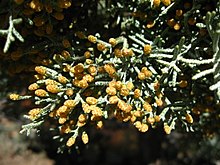| Hesperocyparis glabra | |
|---|---|

| |
| Male pollen cones | |

| |
| Hesperocyparis glabra red bark peeling on trunk, Coconino National Forest, Arizona | |
|
Scientific classification
| |
| Kingdom: | Plantae |
| Clade: | Tracheophytes |
| Clade: | Gymnospermae |
| Division: | Pinophyta |
| Class: | Pinopsida |
| Order: | Cupressales |
| Family: | Cupressaceae |
| Genus: | Hesperocyparis |
| Species: | H. glabra
|
| Binomial name | |
| Hesperocyparis glabra (
Sudw.) Bartel
| |
| Synonyms [2] | |
| |
Hesperocyparis glabra, known as the Arizona smooth bark cypress or smooth Arizona cypress, is a conifer native to the American Southwest, with a range stretching over the canyons and slopes in a somewhat wide vicinity around Sedona, Arizona. It is distinguished from Hesperocyparis arizonica by its very smooth, non-furrowed bark which can appear in shades of pink, cherry, and grey. [3]
It is often seen in cultivation, as unlike the Monterey cypress, it has proved to be very resistant to cypress canker. [4]
Taxonomy
Hesperocyparis glabra was scientifically described by George Bishop Sudworth in 1910 with the name of Cupressus glabra. [2] [5] In 1966 the botanist Elbert Luther Little published a paper where he argued that it was a subspecies of what was then Cupressus arizonica. [2] Along with the other new world Cupressus species it was transferred to the new genus Hesperocyparis in 2009. At the same time the authors restored it as a species under its present name. [2] [6]
As of 2024 [update] Hesperocyparis glabra is listed as the accepted species name with no subspecies by Plants of the World Online (POWO), [2] World Flora Online, [7] and the USDA Natural Resources Conservation Service PLANTS database (PLANTS). [8]
References
- ^ Farjon, A. (2013). "Cupressus arizonica var. glabra". IUCN Red List of Threatened Species. 2013: e.T19708408A19708411. doi: 10.2305/IUCN.UK.2013-1.RLTS.T19708408A19708411.en. Retrieved 25 September 2021.
- ^ a b c d e "Hesperocyparis glabra (Sudw.) Bartel". Plants of the World Online. Royal Botanic Gardens, Kew. Retrieved 14 February 2024.
- ^ Earle, Christopher J. (2023). "Hesperocyparis glabra (smooth Arizona cypress) description". The Gymnosperm Database. Retrieved 14 February 2024.
- ^ "Hesperocyparis glabra (Arizona Cypress, Cuyamaca Cypress, Piute Cypress, Smooth Arizona Cypress)". North Carolina Extension Gardener Plant Toolbox. North Carolina State University. Retrieved 15 February 2024.
- ^ Sudworth, George Bishop (1910). "A New Cypress for Arizona". American Forestry. 16. Washington, D.C.: American Forestry Association: 88–90. Retrieved 14 February 2024.
- ^ Adams, Robert P.; Bartel, Jim A.; Price, Robert A. (2009). "A new genus, Hesperocyparis, for the cypresses of the Western Hemisphere" (PDF). Phytologia. 91 (1): 160–185. Retrieved 14 February 2024.
- ^ "Hesperocyparis glabra (Sudw.) Bartel". World Flora Online. Retrieved 14 February 2024.
- ^ Hesperocyparis glabra, USDA Natural Resources Conservation Service PLANTS Profile, 14 February 2024
External links
-
 Media related to
Cupressus glabra at Wikimedia Commons
Media related to
Cupressus glabra at Wikimedia Commons - Cupressus.net: Cupressus glabra
- Gymnosperm database.org: Cupressus glabra
